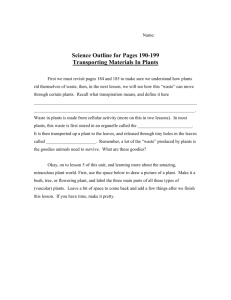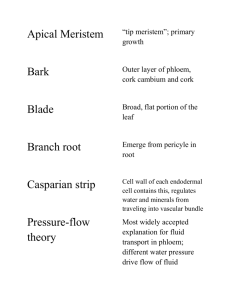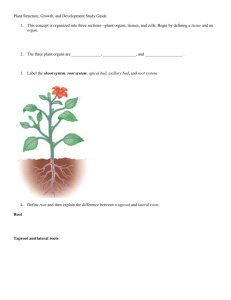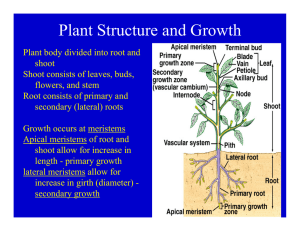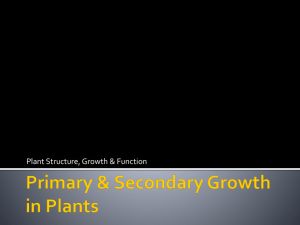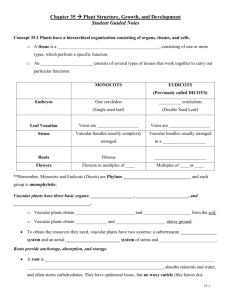Chapter 30 and 35: Plants I
advertisement
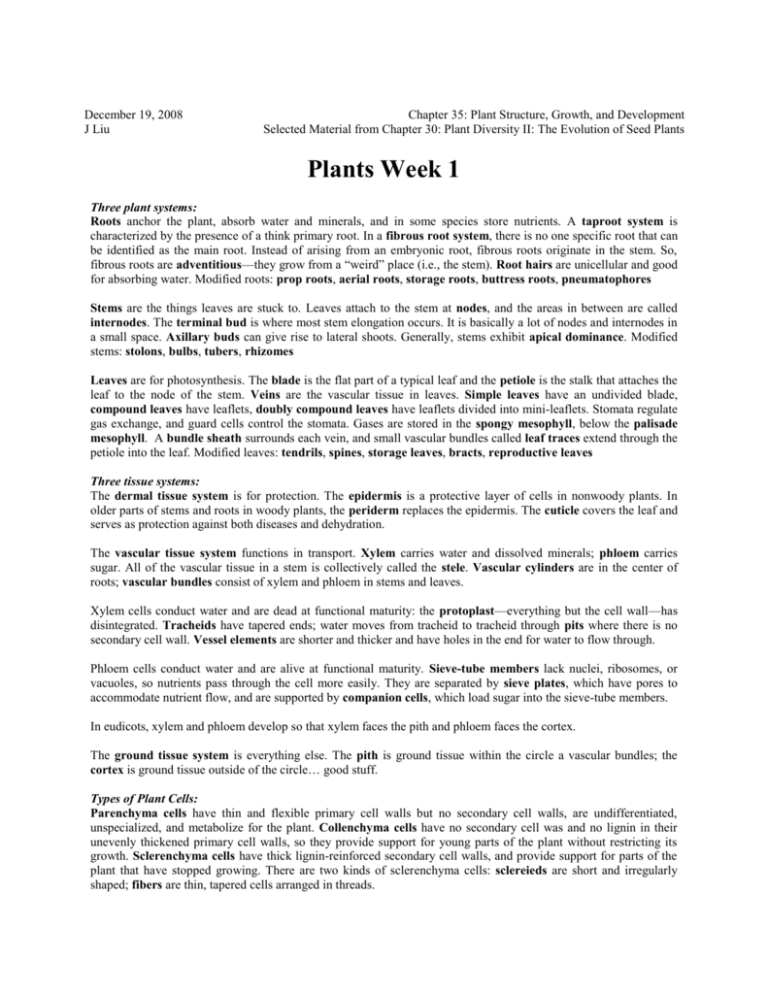
December 19, 2008 J Liu Chapter 35: Plant Structure, Growth, and Development Selected Material from Chapter 30: Plant Diversity II: The Evolution of Seed Plants Plants Week 1 Three plant systems: Roots anchor the plant, absorb water and minerals, and in some species store nutrients. A taproot system is characterized by the presence of a think primary root. In a fibrous root system, there is no one specific root that can be identified as the main root. Instead of arising from an embryonic root, fibrous roots originate in the stem. So, fibrous roots are adventitious—they grow from a “weird” place (i.e., the stem). Root hairs are unicellular and good for absorbing water. Modified roots: prop roots, aerial roots, storage roots, buttress roots, pneumatophores Stems are the things leaves are stuck to. Leaves attach to the stem at nodes, and the areas in between are called internodes. The terminal bud is where most stem elongation occurs. It is basically a lot of nodes and internodes in a small space. Axillary buds can give rise to lateral shoots. Generally, stems exhibit apical dominance. Modified stems: stolons, bulbs, tubers, rhizomes Leaves are for photosynthesis. The blade is the flat part of a typical leaf and the petiole is the stalk that attaches the leaf to the node of the stem. Veins are the vascular tissue in leaves. Simple leaves have an undivided blade, compound leaves have leaflets, doubly compound leaves have leaflets divided into mini-leaflets. Stomata regulate gas exchange, and guard cells control the stomata. Gases are stored in the spongy mesophyll, below the palisade mesophyll. A bundle sheath surrounds each vein, and small vascular bundles called leaf traces extend through the petiole into the leaf. Modified leaves: tendrils, spines, storage leaves, bracts, reproductive leaves Three tissue systems: The dermal tissue system is for protection. The epidermis is a protective layer of cells in nonwoody plants. In older parts of stems and roots in woody plants, the periderm replaces the epidermis. The cuticle covers the leaf and serves as protection against both diseases and dehydration. The vascular tissue system functions in transport. Xylem carries water and dissolved minerals; phloem carries sugar. All of the vascular tissue in a stem is collectively called the stele. Vascular cylinders are in the center of roots; vascular bundles consist of xylem and phloem in stems and leaves. Xylem cells conduct water and are dead at functional maturity: the protoplast—everything but the cell wall—has disintegrated. Tracheids have tapered ends; water moves from tracheid to tracheid through pits where there is no secondary cell wall. Vessel elements are shorter and thicker and have holes in the end for water to flow through. Phloem cells conduct water and are alive at functional maturity. Sieve-tube members lack nuclei, ribosomes, or vacuoles, so nutrients pass through the cell more easily. They are separated by sieve plates, which have pores to accommodate nutrient flow, and are supported by companion cells, which load sugar into the sieve-tube members. In eudicots, xylem and phloem develop so that xylem faces the pith and phloem faces the cortex. The ground tissue system is everything else. The pith is ground tissue within the circle a vascular bundles; the cortex is ground tissue outside of the circle… good stuff. Types of Plant Cells: Parenchyma cells have thin and flexible primary cell walls but no secondary cell walls, are undifferentiated, unspecialized, and metabolize for the plant. Collenchyma cells have no secondary cell was and no lignin in their unevenly thickened primary cell walls, so they provide support for young parts of the plant without restricting its growth. Sclerenchyma cells have thick lignin-reinforced secondary cell walls, and provide support for parts of the plant that have stopped growing. There are two kinds of sclerenchyma cells: sclereieds are short and irregularly shaped; fibers are thin, tapered cells arranged in threads. Meristems are for growing! Indeterminate growth occurs throughout an organism’s life. Compare to determinate growth, like in humans— we stop growing T_T. Annuals complete their growth in a year or less; biennials live two years; perennials can basically live forever. Associate meristems with plant stem cells. Apical meristems are located at the end of a shoot and are for primary growth; lateral meristems are for secondary growth. Primary growth makes a plant taller/longer, secondary growth increases the width of a plant were primary growth has stopped. In woody plants, the vascular cambium makes secondary xylem and phloem, and the cork cambium replaces the epidermis with periderm. Initials are cells that make new meristem cells; derivatives are displaced from the meristem and will specialize into something…hopefully. The primary plant body is produced by elongation of apical meristems. This includes the entire plant in herbaceous (nonwoody) plants and the newest part of the plant in woody plants. In root cells, primary growth involves the zone of cell division, zone of elongation, and zone of maturation. The root cap protects the tip of the root as it grows. In shoots, leaf primorida next to the apical meristem give rise to leaves. Secondary growth makes plants fatter and occurs IN WOODY PLANTS ONLY. The secondary plant body is the added to the plant by the vascular and cork cambiums. In vascular cambiums, fusiform initials make secondary xylem and phloem. Ray initials transport nutrients and water between the xylem and phloem. In cork cambiums, phelloderm forms on the interior of the cork cambium while cork cells on the outside deposit suberin to protect the plant against water loss and pathogens. Lenticels are areas where there is more space between cork cells so that cells in older parts of the plant can exchange gases with the air. Bark refers to all tissues outside the vascular cambium. Plant Morphogenesis—development of body form and organization Some Basics: In asymmetrical cell division, one daughter cell receives more cytoplasm (mitosis). The plane in which a cell divides is determined at interphase—the preprophase band, a concentrated ring of microtubules, marks the plane of cell division will be. OK! Now you’re ready! …I sound like a computer game or something. Cell expansion in plants results mostly from water uptake. The plant cell wall contains microfibrils; the cell expands perpendicular to the grain of these microfibrils. How the microfibrils are oriented in turn depends on microtubules in the cell wall. Pattern formation is development of certain structures in specific places depending on positional information. Polarity is a kind of pattern formation that causes different structures at opposite ends of an organism. Root/shoot polarity (and probably any kind of polarity) is hard to reverse. A cell’s final position in a plant will determine what kind of cell it becomes. A phase change is a shift from one developmental stage to another. Phase changes can occur within one plant because the axial meristems lay down juvenile nodes and internodes before it matures. Genetic Control of Flowering Meristem identity genes cause switch from vegetative growth to flowering. Organ identity (plant homeotic) genes regulate flower pattern. ABC Model: A Sepals B A Petals B C Stamens C Carpels Difference Between Monocots and Dicots Monocots Dicots One cotyledon Two cotyledons Parallel veins Netted veins Vascular tissue scattered Vascular tissue in bundles Fibrous root system Taproot system C Carpels B C Stamens Monocots Floral organs in threes Pollen grain 1 opening E.g. Orchid, Barley B A Petals A Sepals Dicots Floral organs in 4’s , 5’s Pollen grain 3 openings E.g. Pea, Oak


